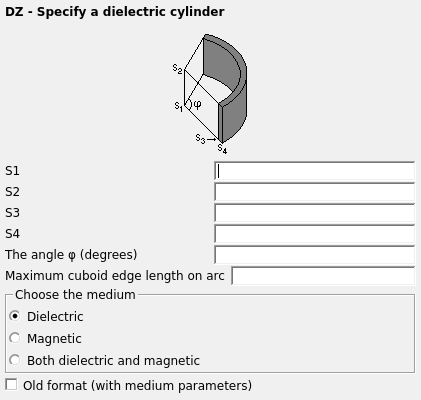DZ Card
The DZ card is used to create a cylindrical shell, meshed into cuboidal elements for using the volume equivalence principle in the method of moments. The meshing parameters as set at the IP card are used, and the medium as set at the ME card is assigned to all created cuboidal elements.
On the Construct tab, in the Volumes group,
click the ![]() Cylinder (DZ) icon.
Cylinder (DZ) icon.

Figure 1. The DZ - Specify a dielectric cylinder dialog
Parameters:
- S1
- The start point of the cylinder axis.
- S2
- The end point of the cylinder axis.
- S3
- Point on the inside of the shell.
- S4
- Point on the outside of the shell.
- The angle
- The angle of the cylindrical segment in degrees.
- Maximum cuboid edge length on arc
- Maximum edge length of the cuboids along the arc in m (is scaled by the SF card). If this parameter is left empty, the value specified with the IP card is used.
- Choose the medium
- Select here whether the cylindrical shell is dielectric or magnetic or both (this is always with respect to the environment, for example if the relative permittivity of the cuboid material differs from the environment, then this is a dielectric cylinder).
- Old format (with medium parameters)
- For a detailed description of this parameter please see the QU card.
Dielectric bodies treated with the volume equivalence principle (using cuboids) cannot be used simultaneously with dielectric bodies treated with the surface equivalence principle or the FEM or with special Green’s functions.
Example of DZ card usage
Below is an example of a cylindrical shell created with the DZ card.

Figure 2. Example of an cylindrical shell created with the DZ card.